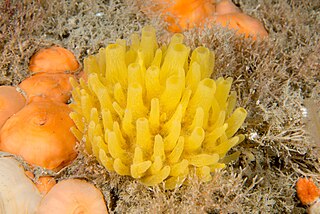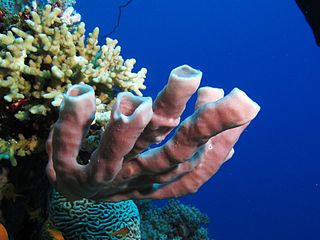
Polymastia is a genus of sea sponges containing about 30 species. These are small to large encrusting or dome-shaped sponges with a smooth surface having many teat-shaped projections (papillae). In areas of strong wave action, this genus does not grow the teat structures, but instead grows in a corrugated form.

Axinella is a genus of sponges in the family Axinellidae first described in 1862 by Eduard Oscar Schmidt. Species of Axinella occur in the Indian and Pacific Oceans. Most of these sponges are smaller than 20 cm, and have a yellow or orange colour.
Hymeniacidon is a genus of sea sponges in the class Demospongiae. Some members of the genus are known to be mobile, achieving speeds of between 1 and 4 mm per day.

Stelletta is a genus of sea sponges belonging to the family Ancorinidae.

Microcionidae is a family of marine demosponges.
Isodictya is a genus of marine demosponge in the family Isodictyidae.

Myxilla is a genus of demosponge belonging to the family Myxillidae. These sponges usually form encrustations on rock surfaces.

Callyspongiidae is a family of sea sponges in the order Haplosclerida. It contains the following genera and species:
Calthropella is a genus of sea sponges in the order Tetractinellida. It is the only genus in the monotypic family Calthropellidae.

Craniella is a genus of marine sponges in the family Tetillidae.

Euplectellidae is a family of glass sponges (Hexactinellids) belonging to the order Lyssacinosa, first represented in the Ordovician fossil record, substantially older than molecular estimates of the clade's age.

Tedania is a genus of sea sponges in the family Tedaniidae.
Esperiopsis is a genus of demosponges, comprising around 30 species found in oceans around the world.

Antho is a genus of sponges belonging to the family Microcionidae. The genus has a cosmopolitan distribution and is known from virtually all parts of the global ocean. There are 62 species in five subgenera.

Iophon is a genus of sponges belonging to the family Acarnidae. The genus has a cosmopolitan distribution.

Coelosphaeridae is a family of sponges belonging to the order Poecilosclerida. Species are found across the globe.
Hamacantha is a genus of sponges in the family Hamacanthidae. This species in this genus differ from those in the other genera in this family through the presence of diancistras, distinctive microscleres. These are thought to aid in framing the skeleton by joining monactine megascleres. This genus contains 30 species in three subgenera.

Phorbas is a genus of demosponges belonging to the family Hymedesmiidae.

Latrunculia is a genus of demosponges. It is well known for the diverse array of chemical compounds found in its species, including the latrunculins, which are named after this genus. Many of these are medically important, including anti-cancer compounds such as discorhabdins.
Corticium is a genus of sponges in the order Homosclerophorida first described by Eduard Oscar Schmidt in 1862.













